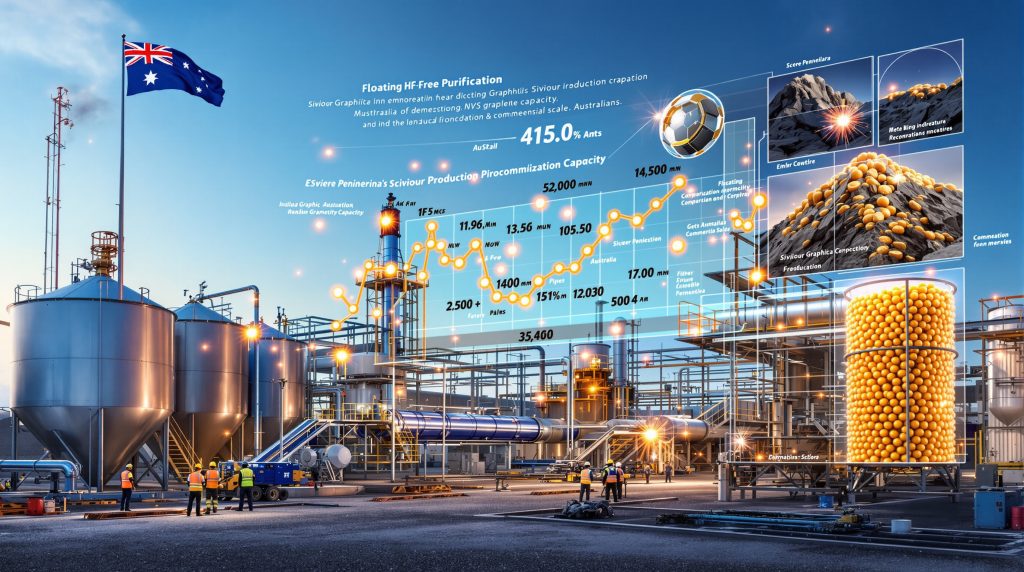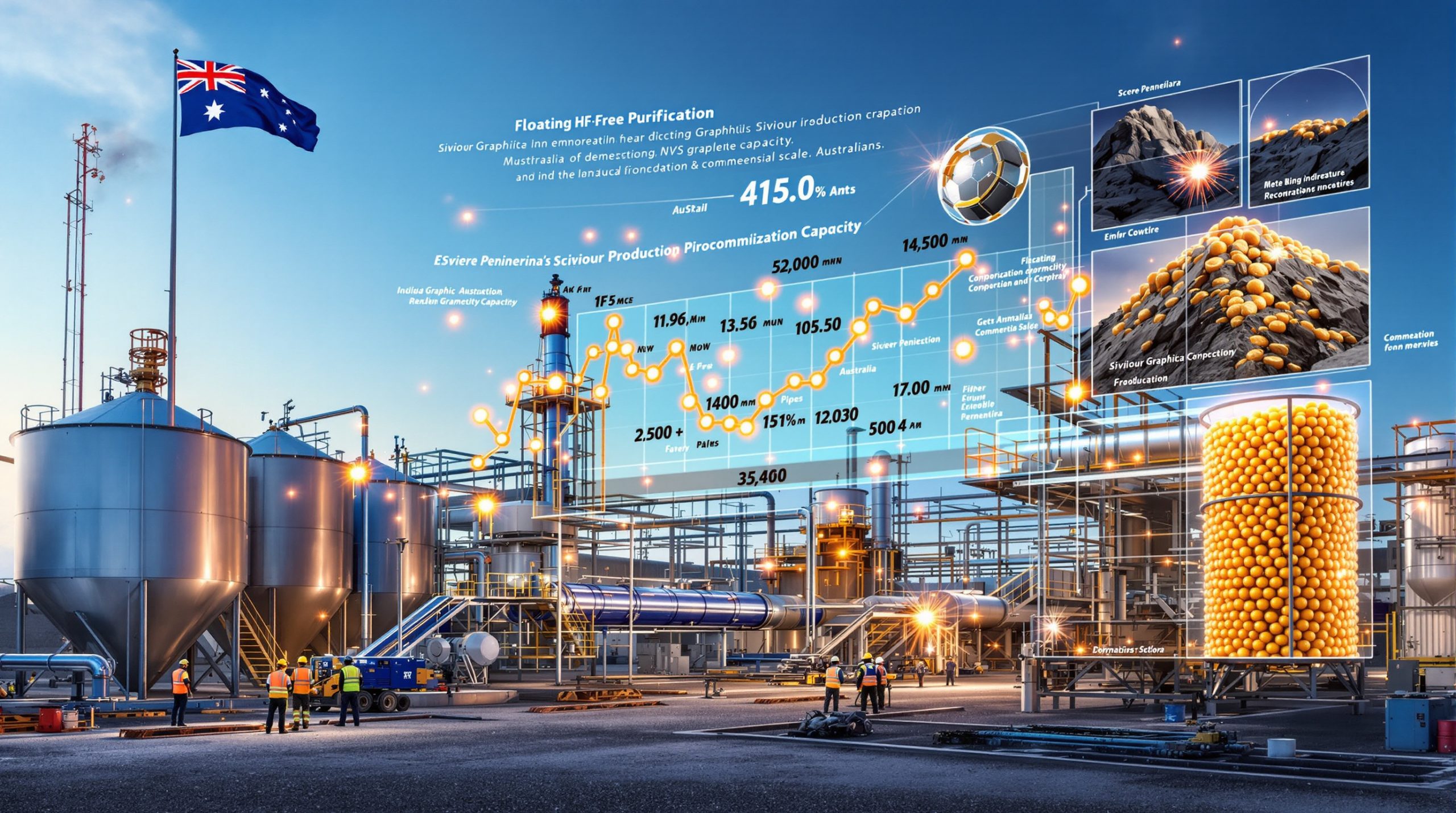Technological Evolution in Advanced Processing Infrastructure
The transformation of Australia's critical minerals sector reflects a broader shift toward sophisticated manufacturing capabilities and vertical integration strategies. As global supply chains face increasing scrutiny, domestic processing facilities represent more than infrastructure development. They embody strategic positioning in the emerging battery materials economy, where the Renascor Resources graphite facility exemplifies technological differentiation and operational excellence determining market access and competitive sustainability.
Contemporary graphite processing developments illustrate this evolution through integrated approaches combining resource extraction, purification technology, and end-use application engineering. Furthermore, the intersection of environmental compliance, technical innovation, and supply chain security creates unique opportunities for companies capable of executing complex industrial projects while maintaining operational efficiency and safety standards.
Advanced Material Handling Systems Implementation
Motor Control Infrastructure and Electrical Systems Integration
The deployment of sophisticated electrical control systems represents a critical foundation for advanced processing operations. Modern motor control centres incorporate programmable logic controllers, variable frequency drives, and integrated safety systems designed to manage complex material flow patterns throughout processing facilities.
Key electrical infrastructure components include:
- High-voltage distribution systems for industrial-scale processing equipment
- Automated control networks linking material handling and processing systems
- Safety interlock systems preventing equipment damage during operational transitions
- Real-time monitoring capabilities for electrical consumption and performance metrics
The integration of these systems requires careful coordination between electrical contractors and process engineers to ensure compatibility with downstream processing requirements. In addition, proper implementation enables remote monitoring and control capabilities essential for optimizing throughput while maintaining quality standards.
Screw Conveyor Systems and Material Transportation
Material handling efficiency directly impacts processing capacity and operational costs in graphite purification facilities. Screw conveyor systems provide controlled material transportation while minimizing degradation of fragile graphite particles during movement between processing stages.
Technical specifications for advanced conveyor systems:
- Stainless steel construction for corrosion resistance and contamination prevention
- Variable speed controls for precise material flow regulation
- Enclosed designs preventing material loss and environmental exposure
- Integrated weighing systems for accurate batch control and inventory management
Modern conveyor installations incorporate sophisticated monitoring systems that track material flow rates, power consumption, and mechanical wear patterns. Consequently, this data enables predictive maintenance strategies that minimize unplanned downtime while extending equipment operational life.
Water Treatment Infrastructure and Environmental Compliance
Environmental regulations governing industrial water discharge require comprehensive treatment systems capable of removing processing contaminants to acceptable levels. Advanced water treatment facilities incorporate multiple purification stages addressing specific pollutants generated during graphite processing operations.
Multi-stage treatment processes typically include:
- Primary settling for suspended solids removal
- Chemical precipitation for dissolved metal extraction
- Activated carbon filtration for organic compound removal
- Reverse osmosis systems for final polishing to discharge standards
Off-site commissioning protocols validate system performance against regulatory requirements before facility integration. This approach reduces project risk while ensuring environmental compliance from initial operations commencement.
Critical Equipment Integration and Process Optimization
Kiln Installation Requirements and Thermal Processing Systems
Thermal processing represents the core technology in advanced graphite purification, requiring specialised kiln systems capable of achieving precise temperature profiles while maintaining atmospheric control. The integration of these systems demands extensive preparatory infrastructure and coordinated installation procedures.
Kiln installation considerations include:
- Reinforced foundation systems capable of supporting equipment weight and thermal expansion
- High-temperature refractory lining systems for thermal efficiency and equipment protection
- Automated temperature control systems maintaining precise heating profiles
- Exhaust gas treatment systems for emissions compliance and heat recovery
The December 1 delivery milestone mentioned in recent industry evolution trends reflects the critical path nature of kiln integration in facility commissioning schedules. However, delays in major equipment arrival can cascade through subsequent installation activities, making precise logistics coordination essential for maintaining project timelines.
Process Piping Networks and Fluid Handling Systems
Complex processing facilities require extensive piping networks for material transport, cooling water circulation, and waste handling. Proper design and installation of these systems ensures reliable operation while minimising maintenance requirements and safety hazards.
Engineering considerations for process piping:
- Material compatibility with processing chemicals and temperatures
- Pressure rating specifications for system operating conditions
- Expansion joint placement for thermal stress management
- Valve selection and placement for operational flexibility and maintenance access
Pump alignment procedures ensure optimal performance and equipment longevity through precise mechanical positioning and vibration control. Similarly, agitator installation requires careful attention to shaft alignment and bearing support systems to prevent premature failure under continuous operation conditions.
Environmental Technology and Sustainable Processing Methods
Hydrofluoric Acid Alternative Technologies
Traditional graphite purification methods rely heavily on hydrofluoric acid for removing mineral impurities, creating significant environmental and safety challenges. Alternative processing technologies eliminate HF usage while maintaining purification effectiveness, representing a fundamental shift in industry practices aligned with sustainability transformation initiatives.
Advantages of HF-free purification include:
- Elimination of hazardous chemical handling and storage requirements
- Reduced occupational health risks for facility personnel
- Simplified waste treatment and disposal procedures
- Lower environmental compliance costs and regulatory oversight
The technical mechanisms underlying HF-free purification typically involve alternative chemical reagents or physical separation techniques that achieve similar impurity removal without fluorine compounds. These methods often require higher temperatures or longer processing times but eliminate the safety and environmental concerns associated with HF handling.
Purification Efficiency and Quality Assurance
Battery-grade graphite requires extremely high purity levels, typically exceeding 99.95% graphitic carbon content. Achieving these specifications consistently demands sophisticated quality control systems and process optimisation capabilities.
Quality assurance protocols include:
- Real-time compositional analysis using X-ray fluorescence spectroscopy
- Particle size distribution monitoring through laser diffraction analysis
- Surface area measurements via gas adsorption techniques
- Electrochemical performance testing for battery application validation
Advanced processing facilities incorporate automated sampling systems that continuously monitor product quality throughout production runs. This capability enables immediate process adjustments to maintain specifications while maximising throughput efficiency.
Demonstration Plant Operations and Commercial Scale Development
Performance Monitoring and Data Collection Systems
Demonstration facilities serve as critical testing grounds for validating process technologies before commercial-scale implementation. Data-driven mining operations capture operational parameters, equipment performance, and product quality metrics essential for scale-up engineering.
Data collection categories include:
- Process variables: temperature, pressure, flow rates, residence times
- Equipment performance: energy consumption, throughput rates, maintenance intervals
- Product characteristics: purity levels, particle properties, yield percentages
- Environmental metrics: emissions levels, waste generation, energy efficiency
Modern monitoring systems incorporate industrial internet-of-things (IIoT) sensors that provide continuous data streams for analysis and optimisation. Machine learning algorithms can identify patterns in operational data that suggest process improvements or predict equipment maintenance needs.
Scale-Up Engineering and Capacity Expansion
Translating demonstration plant performance to commercial-scale operations requires sophisticated engineering analysis to account for non-linear scaling effects. Heat transfer, mixing efficiency, and residence time distributions often behave differently at larger scales, requiring careful modelling and validation.
Scale-up considerations include:
- Heat transfer coefficient changes with equipment size
- Mixing intensity variations in larger processing vessels
- Material flow pattern modifications in scaled systems
- Control system response times for larger process volumes
Engineering teams typically employ computational fluid dynamics modelling and pilot plant testing to validate scale-up assumptions before committing to commercial facility designs. This approach minimises technical risks while optimising capital efficiency.
Resource Integration and Supply Chain Security
Siviour Deposit Characteristics and Strategic Positioning
The Siviour graphite project in South Australia's Eyre Peninsula represents one of the world's largest identified graphite resources, providing strategic supply security for domestic processing operations. The deposit's proximity to existing infrastructure and processing facilities creates unique logistical advantages for integrated operations.
Resource characteristics contributing to strategic value:
- Large-scale resource base supporting long-term operations
- Favourable geology enabling efficient extraction methods
- Strategic location providing access to transportation infrastructure
- Proximity to skilled workforce and industrial suppliers
Vertical integration from mining through processing enables quality control throughout the entire supply chain while reducing dependence on external suppliers. This approach becomes increasingly valuable as battery manufacturers seek supply chain transparency and reliability assurance.
Mine-to-Processing Integration Benefits
Direct integration between mining operations and processing facilities provides operational advantages beyond simple transportation cost savings. Quality consistency, inventory management, and production scheduling optimisation all benefit from coordinated operations.
Integration advantages include:
- Optimised concentrate specifications for processing requirements
- Reduced inventory costs through coordinated production scheduling
- Enhanced quality control from ore extraction through final product
- Simplified logistics and transportation arrangements
The Renascor Resources graphite facility development represents this integration approach, where concentrate from the Siviour deposit will supply the Adelaide processing facility directly, eliminating third-party material handling and associated quality risks.
Safety Performance and Project Risk Management
Zero Harm Safety Achievement and Industry Standards
Construction safety performance serves as a leading indicator of project management effectiveness and operational discipline. Achieving zero lost-time injuries during complex industrial construction demonstrates comprehensive safety management systems and contractor coordination.
Safety management system components:
- Comprehensive risk assessment and hazard identification procedures
- Mandatory safety training and competency verification for all personnel
- Regular safety audits and performance monitoring systems
- Emergency response protocols and incident investigation procedures
According to Safe Work Australia data, the construction industry historically experiences higher injury rates than manufacturing sectors, making zero lost-time injury achievements particularly significant for complex industrial projects.
| Safety Metric | Industry Average | Best Practice Target | Project Achievement |
|---|---|---|---|
| Lost-Time Injury Frequency Rate | 2.8 per 100,000 hours | <1.0 per 100,000 hours | 0.0 per 100,000 hours |
| Total Recordable Injury Rate | 8.5 per 100,000 hours | <3.0 per 100,000 hours | Data not disclosed |
| Medical Treatment Injuries | 5.7 per 100,000 hours | <2.0 per 100,000 hours | Data not disclosed |
Project Timeline Management and Milestone Achievement
Complex industrial construction projects require sophisticated scheduling and resource coordination to maintain critical path milestones. Effective project management systems integrate equipment delivery, contractor scheduling, and commissioning activities to optimise overall timeline performance.
Critical milestone categories include:
- Major equipment delivery and positioning
- Structural construction and infrastructure completion
- Electrical and control system installation
- Process equipment commissioning and performance testing
The reported on-schedule performance for the Renascor Resources graphite facility reflects effective project management practices during a period when many industrial projects face supply chain delays and skilled labour shortages.
Government Investment and Strategic Industry Development
Critical Minerals Initiative and Co-Funding Programs
The Australian Government's critical minerals strategy recognises graphite as essential for battery supply chain security and domestic manufacturing capability development. Co-funding programs provide financial support for processing facility development while advancing national strategic objectives.
Government investment priorities include:
- Reducing dependence on Chinese processing capacity
- Developing domestic value-added manufacturing capabilities
- Supporting technology development and innovation
- Creating regional employment and economic development opportunities
Co-funding arrangements typically require private sector investment matching government contributions while meeting specific performance and employment targets. These partnerships enable project development that might not be commercially viable without government support.
Economic Development and Regional Impact
Advanced processing facilities create high-skilled employment opportunities while supporting broader industrial development in regional areas. The economic multiplier effects extend beyond direct employment to supporting services and supply chain development.
Economic impact categories:
- Direct employment in operations, maintenance, and technical roles
- Indirect employment in supporting services and suppliers
- Export revenue generation from value-added products
- Technology transfer and knowledge development for broader industry application
The Adelaide facility location provides access to skilled workforce and existing industrial infrastructure while contributing to South Australia's advanced manufacturing sector development.
Global Supply Chain Dynamics and Market Positioning
China Market Dominance and Alternative Supply Requirements
China currently controls approximately 90% of global graphite processing capacity, creating supply chain vulnerability for international battery manufacturers. This concentration drives demand for alternative processing capabilities in stable jurisdictions with reliable regulatory frameworks.
Market dynamics driving diversification include:
- Geopolitical risks associated with supply concentration
- Quality consistency concerns with current supply sources
- Environmental standards differences between processing locations
- Supply chain transparency requirements from end-use customers
International battery manufacturers increasingly prioritise supply chain diversification to reduce dependence on single-country sources while meeting environmental and social governance requirements.
Electric Vehicle Growth and Graphite Demand Projections
Global electric vehicle adoption continues accelerating, driving substantial increases in lithium-ion battery production and associated graphite demand. Each electric vehicle requires approximately 50-100 kilograms of graphite for battery anodes, compared to minimal quantities in conventional vehicles.
Market growth projections suggest:
- Electric vehicle sales reaching 30% of global auto sales by 2030
- Grid-scale energy storage deployments expanding rapidly
- Consumer electronics continuing steady battery demand growth
- Industrial and commercial battery applications increasing
These demand projections support investment in new processing capacity while creating opportunities for suppliers offering reliable, high-quality alternatives to existing supply sources. Furthermore, the energy transition in minerals creates unprecedented opportunities for domestic processing facilities.
"The convergence of supply chain security concerns, environmental requirements, and demand growth creates unique positioning opportunities for domestic processing capabilities in stable jurisdictions with advanced technical capabilities."
Future Development Pathways and Industry Evolution
What Technology Development Opportunities Exist?
Advanced graphite processing technology continues evolving toward higher efficiency, lower environmental impact, and improved product characteristics. Innovation opportunities exist in purification chemistry, thermal processing optimisation, and automated quality control systems.
Technology development areas include:
- Advanced purification methods reducing processing time and energy consumption
- Automated quality control systems enabling real-time process optimisation
- Waste heat recovery systems improving overall energy efficiency
- Digital twin modelling for predictive maintenance and performance optimisation
Companies investing in demonstration facilities position themselves to capture these technology improvements while developing intellectual property and operational expertise.
Strategic Partnerships and Market Integration
Successful graphite processing operations increasingly depend on long-term customer relationships and integrated supply chain arrangements. Direct partnerships with battery manufacturers provide demand security while enabling customised product development.
Partnership opportunities include:
- Offtake agreements providing revenue certainty and customer commitment
- Joint development programmes for specialised graphite products
- Technology licensing arrangements leveraging process innovations
- Integrated manufacturing partnerships combining processing and battery production
The evolution toward integrated supply chains reflects broader trends in battery manufacturing where quality consistency and supply reliability take precedence over simple cost optimisation. Additionally, reclamation and innovation practices ensure sustainable long-term operations.
Moreover, recent developments at Renascor's graphite projects demonstrate the commercial viability of integrated Australian operations in the global battery materials market.
Disclaimer: This analysis contains forward-looking statements and projections based on current market conditions and industry trends. Actual developments may differ significantly from projections due to market volatility, regulatory changes, technological developments, and other factors beyond current visibility. Investment and business decisions should incorporate comprehensive due diligence and professional advice appropriate to specific circumstances.
Looking to Capitalise on Australia's Critical Minerals Boom?
Discovery Alert's proprietary Discovery IQ model delivers instant notifications on significant ASX mineral discoveries across over 30 commodities, including critical minerals like graphite that are driving the energy transition. With advanced processing facilities and government co-funding creating substantial opportunities in this sector, discover how major mineral discoveries have historically generated exceptional returns and begin your 30-day free trial today to stay ahead of the market.




